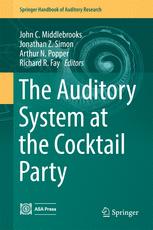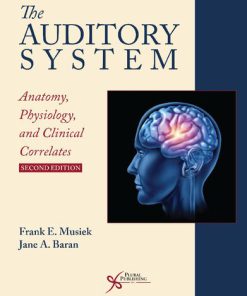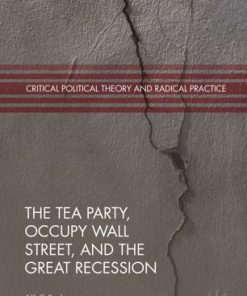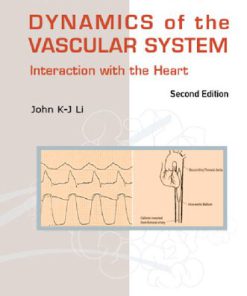The Auditory System at the Cocktail Party 1st Edition by John Middlebrooks, Jonathan Simon, Arthur Popper, Richard Fay 3319516622 9783319516622
$50.00 Original price was: $50.00.$25.00Current price is: $25.00.
The Auditory System at the Cocktail Party 1st Edition by John C. Middlebrooks, Jonathan Z. Simon, Arthur N. Popper, Richard R. Fay – Ebook PDF Instant Download/DeliveryISBN: 3319516622, 9783319516622
Full download The Auditory System at the Cocktail Party 1st Edition after payment.

Product details:
ISBN-10 : 3319516622
ISBN-13 : 9783319516622
Author: John C. Middlebrooks, Jonathan Z. Simon, Arthur N. Popper, Richard R. Fay
The Auditory System at the Cocktail Party is a rather whimsical title that points to the very serious challenge faced by listeners in most everyday environments: how to hear out sounds of interest amid a cacophony of competing sounds. The volume presents the mechanisms for bottom-up object formation and top-down object selection that the auditory system employs to meet that challenge. Ear and Brain Mechanisms for Parsing the Auditory Scene by John C. Middlebrooks and Jonathan Z. Simon Auditory Object Formation and Selection by Barbara Shinn-Cunningham, Virginia Best, and Adrian K. C. Lee Energetic Masking and Masking Release by John F. Culling and Michael A. Stone Informational Masking in Speech Recognition by Gerald Kidd, Jr. and H. Steven Colburn Modeling the Cocktail Party Problem by Mounya Elhilali Spatial Stream Segregation by John C. Middlebrooks Human Auditory Neuroscience and the Cocktail Party Problem by Jonathan Z. Simon Infants and Children at the Cocktail Party by Lynne Werner Older Adults at the Cocktail Party by M. Kathleen Pichora-Fuller, Claude Alain, and Bruce A. Schneider Hearing with Cochlear Implants and Hearing Aids in Complex Auditory Scenes by Ruth Y. Litovsky, Matthew J. Goupell, Sara M. Misurelli, and Alan Kan About the Editors: John C. Middlebrooks is a Professor in the Department of Otolaryngology at the University of California, Irvine, with affiliate appointments in the Department of Neurobiology and Behavior, the Department of Cognitive Sciences, and the Department of Biomedical Engineering. Jonathan Z. Simon is a Professor at the University of Maryland, College Park, with joint appointments in the Department of Electrical and Computer Engineering, the Department of Biology, and the Institute for Systems Research. Arthur N. Popper is Professor Emeritus and Research Professor in the Department of Biology at the University of Maryland, College Park. Richard R. Fay is Distinguished Research Professor of Psychology at Loyola University, Chicago. About the Series: The Springer Handbook of Auditory Research presents a series of synthetic reviews of fundamental topics dealing with auditory systems. Each volume is independent and authoritative; taken as a set, this series is the definitive resource in the field.
The Auditory System at the Cocktail Party 1st Table of contents:
1 Ear and Brain Mechanisms for Parsing the Auditory Scene
Abstract
1.1 Introduction
1.2 Some Central Concepts
1.3 Overview of the Volume
1.4 Ears and Brains
References
2 Auditory Object Formation and Selection
Abstract
2.1 Introduction
2.1.1 The Cocktail Party: Confusing Mixtures and Limited Processing Capacity
2.1.2 Object-Based Attention
2.1.3 Heterarchical Rather Than Hierarchical Processing
2.1.4 A Historical Note
2.2 Parsing the Acoustic Scene: Auditory Object Formation
2.2.1 Local Spectrotemporal Cues Support “Syllable-Level” Object Formation
2.2.2 Higher-Order Features Link Syllables into “Streams”
2.2.3 Open Questions
2.3 Focusing Attention: Selecting What to Process
2.3.1 Top-Down Control Guides Selection
2.3.2 Bottom-up Salience Influences Attention
2.3.3 Extracting Meaning from Imperfect Objects
2.4 Perceptual Consequences of Object-Based Auditory Selective Attention
2.4.1 Failure to Divide Attention
2.4.2 Obligatory Interactions Between Formation and Selection
2.4.3 Costs of Switching Attention
2.5 Neural Mechanisms Supporting Object Formation
2.6 Neural Mechanisms Supporting Object Selection
2.6.1 Visual Cognitive Networks Controlling Attention
2.6.2 Auditory Spatial Attention Engages Visual Orienting and Reorienting Networks
2.6.3 Nonspatial Auditory Attention Differentially Engages Auditory-Specific Networks
2.6.4 Both Sensory Modality and Task Demands Affect Network Activity
2.6.5 Entrainment of Neural Responses to Attended Speech
2.6.6 Other Neural Signatures of Focused Auditory Attention
2.7 Summary Comments
References
3 Energetic Masking and Masking Release
Abstract
3.1 Introduction
3.2 Segregation by Fundamental Frequency
3.2.1 The Effect of an F0 Difference
3.2.2 Selecting Harmonic Components of a Common F0
3.2.3 Temporal Analysis
3.2.4 Effects of Peripheral Nonlinearity
3.2.5 Cancellation Mechanisms
3.2.6 Level of Processing
3.2.7 Conclusions
3.3 Masking and Masking Release by Envelope Fluctuations
3.3.1 Listening in the Dips
3.3.2 Effects of Peripheral Nonlinearity
3.3.3 Modulation Masking
3.3.4 Intrinsic Modulation in Noises
3.3.5 Models Based on Modulation Filter Banks
3.3.6 Dip Listening in the Hearing Impaired
3.3.7 Conclusions
3.4 Spatial Release from Masking
3.4.1 Better-Ear Listening
3.4.2 Binaural Unmasking
3.4.3 The Problem of “Sluggishness”
3.4.4 Models of SRM
3.4.5 Conclusions
3.5 Other Mechanisms
3.5.1 Effect of Frequency Modulation on Prominence
3.5.2 Onset-Time Differences and the Potential Role of Adaptation
3.6 Summary
References
4 Informational Masking in Speech Recognition
Abstract
4.1 Introduction
4.2 The History of Study of the Special Case of SOS Masking
4.3 Determining Energetic and Informational Masking in SOS Masking
4.3.1 Uncertainty
4.3.2 Controlling/Estimating Energetic Masking
4.3.3 Linguistic Variables
4.3.3.1 Time Reversal
4.3.3.2 Familiar Versus Unfamiliar Languages as Maskers
4.3.3.3 Syntactic and Semantic Content: Predictability and Obligatory Processing
4.4 Models of Binaural Analysis Applied to SOS Masking
4.5 Summary
Acknowledgements
References
5 Modeling the Cocktail Party Problem
Abstract
5.1 Introduction
5.2 Defining the Problem in the Cocktail Party Problem
5.3 Principles of Modeling the Cocktail Party Problem
5.3.1 Algorithmic Strategies
5.3.1.1 The Population-Separation Theory
5.3.1.2 The Temporal Coherence Theory
5.3.1.3 The Inference Theory
5.3.1.4 Spatial Models
5.3.2 Neural Infrastructure
5.4 Bottom-up Models of the Cocktail Party Problem
5.5 Top-Down Processes and the Cocktail Party Problem
5.6 Summary
Acknowledgements
References
6 Spatial Stream Segregation
Abstract
6.1 Introduction
6.2 Psychophysics of Spatial Stream Segregation
6.2.1 Weak Disruption of Stream Integration by Spatial Cues
6.2.2 Robust Stream Segregation by Spatial Cues
6.2.3 Spatial Acuity of Stream Segregation
6.2.4 Acoustic Cues for Spatial Stream Segregation
6.3 A Bottom-Up Substrate for Spatial Stream Segregation
6.3.1 Spatial Stream Segregation in Primary Auditory Cortex
6.3.2 Spatial Rhythmic Masking Release by Cortical Neurons
6.3.3 A Mechanism for Bottom-Up Spatial Stream Segregation
6.4 “Common” Versus “Dedicated” Spatial Representations for Localization and Spatial Stream
6.5 Selection of Objects of Attention
6.5.1 Task-Dependent Modulation of Stimulus Specificity in Behaving Animals
6.5.2 Object Selection in Human Neurophysiology
6.6 Summary, Synthesis, and Future Directions
Acknowledgements
References
7 Human Auditory Neuroscience and the Cocktail Party Problem
Abstract
7.1 Introduction
7.1.1 Common Experimental Methodologies
7.1.2 Chapter Topics
7.2 Neural Basis of Spatial Hearing in Humans
7.3 Neural Basis of Auditory Stream Segregation in Humans: Simple Sounds
7.3.1 Studies Using Limited Attentional Manipulation
7.3.1.1 Simple Tone Patterns
7.3.1.2 Tones and Maskers
7.3.2 Studies Using Explicit Attentional Manipulation
7.3.2.1 Tones and Maskers
7.3.2.2 Competing Simple Patterns
7.3.2.3 Suppressing Attention
7.4 Neural Basis of Auditory Stream Segregation in Humans: Speech
7.4.1 Studies Using Speech in Stationary Noise
7.4.2 Studies Using Competing Speech Streams
7.4.3 Neuroanatomy of Speech-in-Noise Processing
7.5 Other Aspects of the Human Auditory Neuroscience of Cocktail Party Processing
7.5.1 Temporal Coherence
7.5.2 Bottom-up Versus Top-Down Attention
7.6 Summary
Acknowledgements
References
8 Infants and Children at the Cocktail Party
Abstract
8.1 Introduction
8.2 Development of Auditory Coding
8.2.1 Spectral Resolution and Energetic Masking
8.2.2 Fundamental Frequency
8.2.3 Temporal Resolution
8.2.4 Spatial Hearing
8.2.5 Auditory-Visual Correspondence
8.3 Development of Auditory Scene Analysis
8.3.1 Listening to Speech in Speech
8.3.2 Cues Used in Auditory Scene Analysis
8.3.2.1 Frequency Separation
8.3.2.2 Timbre
8.3.2.3 Periodicity
8.3.2.4 Envelope Cues
8.3.2.5 Spatial Cues
Masking Level Difference
Contralateral Masking
Spatial Release from Masking
Summary
8.3.2.6 Visual Cues
8.3.3 Role of Selective Attention
8.4 Summary, Conclusions, and Future Directions
References
9 Older Adults at the Cocktail Party
Abstract
9.1 Introduction
9.2 Auditory Aging
9.2.1 Periphery
9.2.2 Speech Understanding
9.2.3 Psychoacoustics of Temporal Processing and Behavioral Measures of Speech Processing
9.2.3.1 Gap and Duration Detection
9.2.3.2 Temporal Fluctuations in the Amplitude Envelope
9.2.3.3 Synchrony or Periodicity Coding
9.2.3.4 Binaural Processing
9.3 Electrophysiological Measures of Auditory and Cognitive Aging
9.3.1 Brainstem
9.3.2 Cortex
9.3.3 Reconciling Behavioral and Electrophysiological Findings Regarding Age-Related Changes
9.4 Age-Related Differences in Speech Understanding Depending on Masker Type
9.4.1 Steady-State Maskers
9.4.2 Complex and Fluctuating Nonspeech Maskers
9.4.3 Speech Maskers
9.5 Behavioral Measures of Age-Related Differences in the Perceptual Organization of Foreground Vers
9.5.1 Spatial Separation and Release from Masking
9.5.1.1 Real Spatial Separation
9.5.1.2 Simulated Spatial Separation
9.5.2 Speed of Buildup of Stream Segregation
9.5.3 Auditory Spatial Attention
9.5.4 Discourse—Beyond Words and Sentences
9.5.4.1 Adjusting SNR to Study Comprehension of Monologues
9.5.4.2 Adjusting Spatial Separation in Dialogues and Trialogues
9.5.5 Memory
9.6 Cognitive Aging and Sensory-Cognitive Interactions
9.6.1 Cognitive Aging
9.6.2 Sensory-Cognitive Interactions
9.6.2.1 Cognitively Healthy Older Adults
9.6.2.2 Older Adults with Cognitive Loss
9.6.3 Brain Plasticity and Compensation
9.6.3.1 Vocabulary
9.6.3.2 Sentences and Discourse
9.7 Summary
Acknowledgements
References
10 Hearing with Cochlear Implants and Hearing Aids in Complex Auditory Scenes
Abstract
10.1 Introduction
10.2 Adults at the Cocktail Party
10.2.1 Factors that Limit Performance
10.2.2 Physiological Factors that Limit Performance in Hearing Impaired Individuals
10.2.3 Devices
10.2.3.1 Cochlear Implants
10.2.3.2 Hearing Aids
10.3 Adults with Cochlear Implants
10.3.1 Availability of Spatial Cues
10.3.2 Binaural Capabilities of Adult BICI Users
10.3.3 Sound Localization
10.3.4 Binaural Masking Level Differences
10.3.5 SRM in BICI Users
10.3.6 Simulating Aspects of CI Processing for Testing in Normal-Hearing Listeners
10.4 Adults with HAs
10.4.1 Unilateral Versus Bilateral Fitting
10.4.2 Bilateral Benefits
10.4.3 Technological Advances
10.5 Introduction to Pediatric Studies
10.5.1 Studies in Children with BICIs
10.5.2 Sequential Versus Simultaneous BICIs
10.5.3 Children with HAs
10.5.4 Variability and Effects of Executive Function
10.5.5 Future Directions and Clinical Applications
10.6 Conclusions
People also search for The Auditory System at the Cocktail Party 1st:
the cocktail party effect
the cocktail party phenomenon
the cocktail party problem
the cocktail effect
a. what is the cocktail party effect
Tags: The Auditory System, Cocktail Party, John Middlebrooks, Jonathan Simon, Arthur Popper, Richard Fay
You may also like…
Education Studies & Teaching - Education - General & Miscellaneous
Discovering Pluto Exploration at the Edge of the Solar System 1st Edition Dale P. Cruikshank
Politics & Philosophy
Politics & Philosophy - Politics
Territorial Politics And The Party System In Spain 1st Edition Caroline Gray
Medicine
The Auditory System Anatomy Physiology and Clinical Correlates Second Edition Frank E. Musiek
Politics & Philosophy
The Tea Party, Occupy Wall Street, and the Great Recession Nils C. Kumkar
Romance - Other Romance Categories
After The Party Party at the Tower 5 1st Edition M K Moore 9798587281486
Medicine
Leaving it at the office a guide to psychotherapist self care 2nd ed 2nd Edition John C. Norcross












